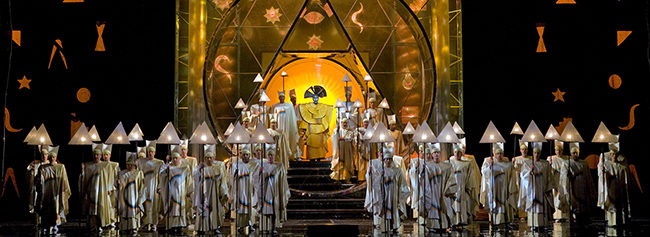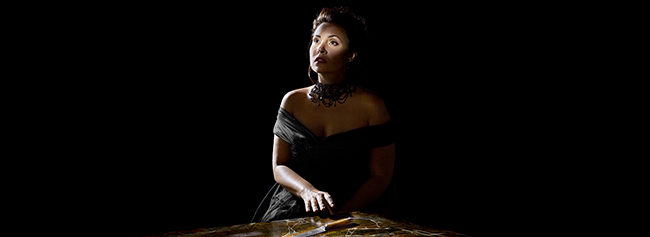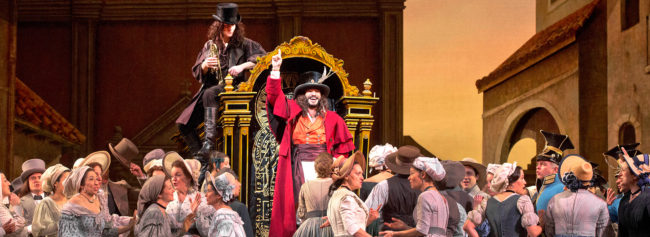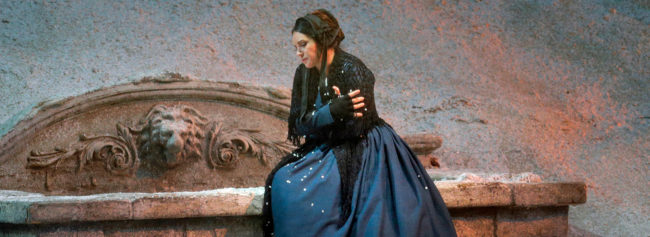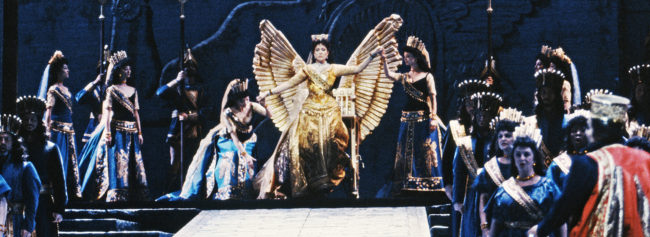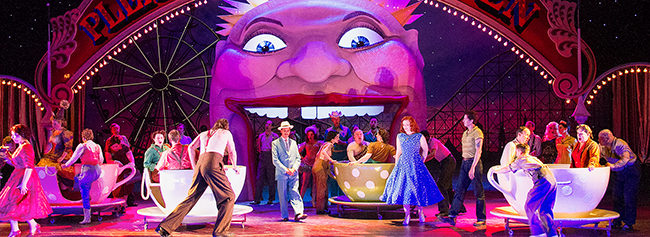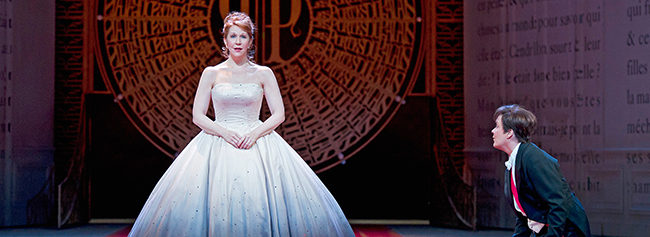SURVIVING PEACE director Josef Avesar will participate in Q&A’s after the 7:20 PM screenings on October 13 at the Royal, October 14 at the Town Center, October 15 at the Claremont, and October 16 at the Playhouse.
Agnes Varda and JR on FACES PLACES: “We embrace chance, we enlist it as an assistant!”
Eighty-nine-year old Agnes Varda, one of the leading figures of the French New Wave, and acclaimed 33-year-old French photographer and muralist JR teamed up to co-direct this enchanting documentary/road movie. Kindred spirits, Varda and JR share a lifelong passion for images and how they are created, displayed and shared. Together they travel around the villages of France in JR’s photo truck meeting locals, learning their stories and producing epic-size portraits of them. The photos are prominently displayed on houses, barns, storefronts and trains revealing the humanity in their subjects, and themselves. Faces Places (originally titled Visages, villages) documents these heart-warming encounters as well as the unlikely, tender friendship they formed along the way. We open the film October 13 at the Royal and Playhouse and October 20 at the Town Center.
In January Agnes and JR had the following conversation based on an interview by Olivier Pere, Director of the cinema unit ARTE FRANCE:
Olivier Père: How did this film come about? Why did you want to make this film together?
JR: Let’s start at the beginning.
Agnès Varda: My daughter Rosalie thought it’d be nice for us to meet. We liked the idea.
JR: I made the first step. I went to see Agnès, at Rue Daguerre. I photographed the legendary façade of her place, where she’s lived a hundred years. And I took photos of her with a cat.
AV: Your grandma’s a hundred, not me. Not yet. The next day, I went to see him at his studio. I took portraits of him, and quickly realized he wasn’t going to remove his sunglasses.
JR: We met again the next day and the day after for tea.
AV: I immediately sensed we’d do something together.
JR: At first we talked about a short film…
AV: … a documentary. It seemed clear that your habit of pasting big pictures of people up on walls, empowering them through size, and my habit of listening to them and spotlighting what they say, would lead to something.
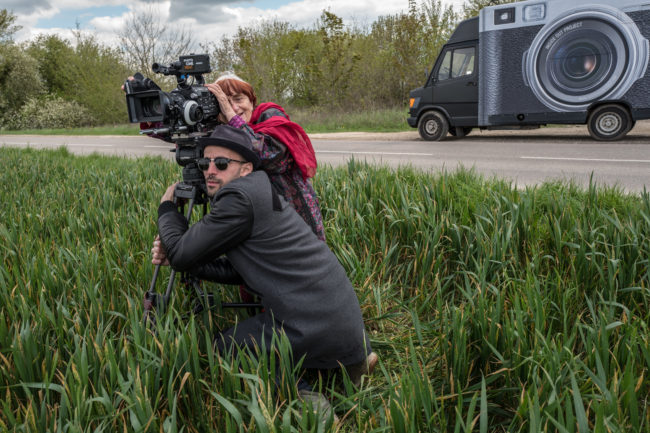
JR: And we wanted to hit the road together. Neither Agnès nor I had ever co-directed a film before.
OP: Why did you choose to focus primarily on people in the French countryside?
JR: Agnès wanted to get me out of cities.
AV: That’s right, because you’re truly an urban artist. And I love the country. We quickly hit on the idea of villages. That’s where we’d meet people, and that’s what happened. We took off in your incredible photo truck. The truck’s the actor in the film, always putting on a show.
JR: I’ve used that truck for years, for lots of projects.
AV: Yes, but this was our project and we set off in it together. At any rate, we had fun driving around
rural France in that truck. Going here and there.
OP: Was there a plan at least, an itinerary? How do you develop a film that’s essentially based on chance? On encounters? On discovery?
AV: Sometimes one of us knew someone in a village or had a specific thing in mind. So we’d go check it out. As always in documentaries – and I’ve done lots of them – you have an idea, but before long, chance enters into play – who you meet and who you know – and suddenly things congeal to focus on a specific person or place. Actually, we embrace chance, we enlist it as an assistant!
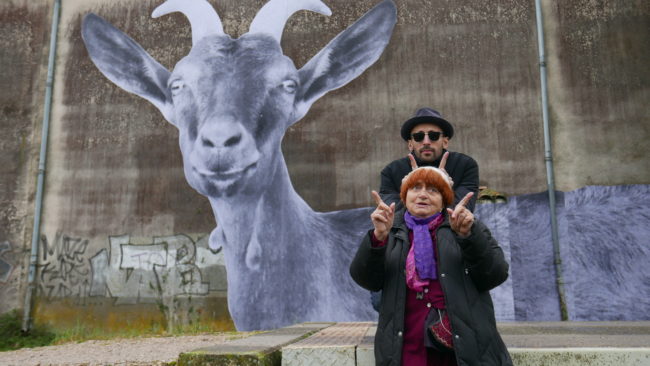
JR: We engage life too, since the film’s also the story of our encounter. We got to know each other on the road through the project and the amusing experience of working as a duo. I’m learning to understand Agnès a little better, what she sees and how she sees it, and she’s also trying to understand my artistic process. We talk a lot and try out ideas. Then we envisioned a feature film.
AV: That’s when Rosalie took the reins to produce it.
JR: You said, “Let’s do this.”
OP: The film is a journey through France but also through memory, both personal and collective. Of workers, farmers and villagers.
JR: Wherever we are, we can tell pretty quickly whether we’re going to make a connection.
AV: One thing I like about you is how fast you work. As soon as we meet someone, you’re already imagining what we could do with them. For instance, the postman in Bonnieux whom I knew and wanted you to meet because I like postmen. I like letters and stamps. You communicate essentially on the web and get 20,000 “likes” when you post an image, and here you agreed to turn that postman into a village hero, in giant format.
JR: Three stories tall.
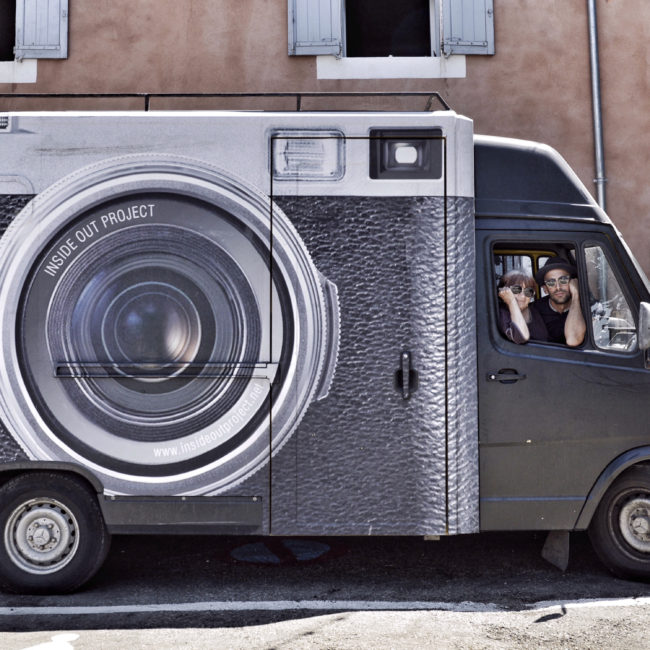
AV: He was proud to be so big. From there we drove to Alpes-de-Haute-Provence.
JR: And someone told us about the factory near Château Arnoux.
AV: I knew the guy from the local movie theater, Jimmy. I’d presented Vagabond there. He showed us the factory.
JR: It’s a little dangerous (an upper-tier Seveso site). We were curious and went to check it out. We met people and came up with some ideas there.
AV: Industrial sites are beautiful. And the people who work there are good-hearted.
JR: They played along with us for a group photo. Some of the other places I assumed I was introducing you to, but it turned out you’d already been there years before. I was inspired by photos you took a long time ago. The collages in the film are the fruit of our collaboration.
AV: Often what you paste up are my photos.
JR: That’s true.
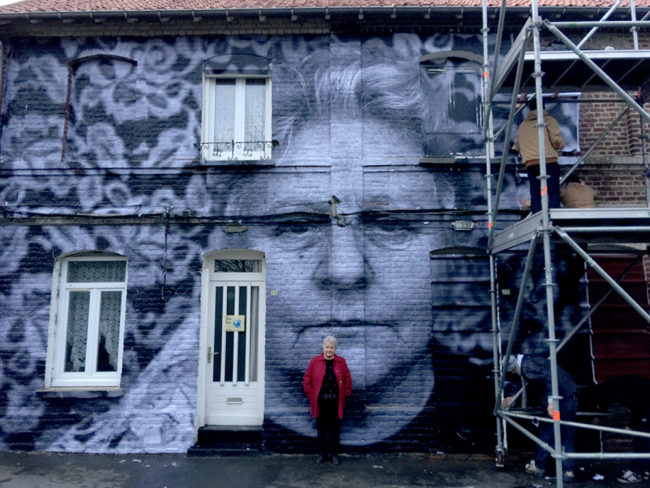
AV: Like the big goat with horns. I took that picture when we were location scouting.
JR: We spent a lot of time with Patricia, the woman who kept her goats’ horns instead of burning them off at birth like everyone else.
AV: People are intense when it comes to their work and words. That woman grew very impassioned about goats and their horns, her conviction was impressive.
JR: And in the North too we heard some powerful things.
AV: The mines are all gone today, but we met a woman, Jeannine, who’s the last inhabitant in a row of miners’ houses. She talked about her father who was a miner, and the former miners shared some beautiful stories about a world we know little about. It was interesting to hear them talk with such fervor. We were touched by Jeannine.
JR: You delve deep when you interview people. I was captivated to see you lead those conversations.
AV: You spoke to them a lot too.
JR: Of course. I’ve always loved doing that in my projects, like I’ve always seen you do in your films, with your own special approach that’s so gentle and delicate… and feminist too.
AV: Ah, I am indeed a feminist!
OP: Women are very present in the film. You show their importance in the agricultural milieu and the working class.
AV: Yes, JR and I both agreed it’s important and makes sense to let women have their say.
JR: That was Agnès’ idea. When I showed her all the photos of the dockworkers in Le Havre, she said, “Where are the women?” So I called the dockworkers back and asked, “Could your wives come to the port?” They said, “Listen, they never have, but maybe this is the chance.” It was pretty crazy to have them discover the port through this project.
AV: Three interesting women with something to say, it was great. I was pleased to see them in the spotlight, “for once,” as one of them said. The dockworkers helped out by putting huge containers at our disposal. We used them like Legos to build towers, make totems. You have to see it, words don’t do justice. What an adventure!
JR: We should also mention the dockworkers were in the middle of one of their biggest strikes. I’m still amazed they gave art such a place of honor, regardless of what was going on.
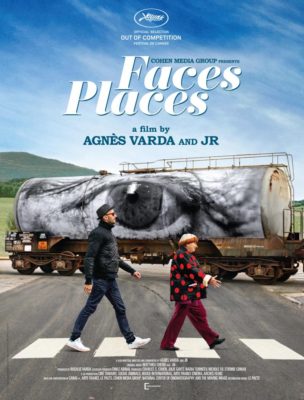
AV: It’s the idea that art is for everyone. The dockworkers agreed to help us because they were keen to participate in an artistic project.
JR: One of the factory workers said, “Art is meant to surprise us!” We disrupted them, but they accepted us. There were serious and complex events going on in France and around the world, yet we were committed to our project and the people we met understood that.
AV: A modest project in a period of widespread chaos.
OP: And in fact, your film is soothing.
AV: They also liked our good cheer and the way you’d tease me. We were intent on being ourselves and involving them in our project.
OP: You develop powerful relationships with the people you meet. You also remember the dead and pay homage to them during your travels: Nathalie Sarraute, Guy Bourdin, Cartier-Bresson.
AV: Yes, I knew them. Evoking them means placing them back in the present. It’s the result that is present. I passed Nathalie Sarraute’s house by chance, and that made me happy, but what we were interested in is the local farmer down the street who farms 2,000 acres on his own.
JR: Another place we filmed was an abandoned village. The place had a past, and we had our photo truck. We held a party with the locals. It’s got a funny name: Pirou-Plage.
AV: And that night there were hundreds of faces up on the walls. We left the next day. We learned since that the village has been demolished. Everything is changing.
JR: We don’t work solidly; our days are specific.
AV: That’s what I’ve always loved with documentaries. You spend a few days with people, you become friends then you lose touch with them, just like the way you depict them with large ephemeral images that will vanish from the walls. We know these moments are magical. The moment of meeting people, the moment of filming, pasting and voilà! I really love that.
JR: The moments don’t last, yet remain engraved.
OP: How did the shoot take place?
AV: We’d take one or two trips then stop, because I’m not strong enough anymore to shoot eight weeks in a row, standing out in the fields. We shot two to four days per month.
JR: I think it worked well. It allowed us to think things through, reflect and see where we were going. We started the editing. We’d talk for hours to figure out where to go and how. I’ve got a more improvisational side to me. “Let’s try, and see if it works.” Agnès, on the other hand, thinks out the whole sequence and a few specific shots. That reinforced the dynamic of our co-direction.
AV: There’s also a gap of several generations between us. Actually we didn’t think about that at all, even if you do climb stairs faster than I do! We were models for each other. That’s how I felt because, by filming the way you work, the way you climb scaffolds, we also get a portrait of you and your work. And you were interested in me too, in my faltering eyes.
JR: Right, we tried to show what’s happening to your eyes. I wanted to see for you, better than you who sees blurry…especially far away. I photographed your eyes very close and showed them from far away. And your toes too!
AV: Oh yes, my toes. I got a chuckle out of your ideas. Your constant teasing, but also the way you invented images of our friendship. It’s true, we share the desire to explore places and forms.
JR: I’d like to talk about something that seems important. Everyone we met taught us something. And vice versa.
AV: When we tell the garage mechanic about the goats with no horns, he says, “Oh, that’s amazing. I’ve learned something new. I’ll tell people about it.”
JR: From one person to another, from one idea to the next. Actually, the film’s a collage.
OP: The entire film’s a collage. With JR pasting giant photos on the walls and Agnès carrying out a cinematographic collage, with rhymes and visual riddles.
AV: I really like the idea that the editing process is a montage, a collage with plays on words and plays on images that take hold so we don’t have to say “chapter 1, chapter 2.” Sometimes I would visualize the montage as a series of words that rhyme [in French]: faces, places, collages, sharing…
OP: And shores. Tell us about the blockhouse, that bunker on the beach.
JR: I often go to Normandy to ride motorcycles on the beach and I discovered a spot where a German blockhouse from the war had fallen off the cliff and was sticking straight up in the middle of the beach. I mentioned it to Agnès but she didn’t seem too interested. Then one day I told her the name of the village and it clicked. She went, “Wait, I
know Saint-Aubin-Sur-Mer, I went there with Guy Bourdin back in the ’50s.” I took her there, and she took me to Guy Bourdin’s house nearby. She showed me the photos she took of him back then. We walked together on the beach and said, “Why not put him here?” The pasting was grueling because we had to go fast. The blockhouse is huge and the tide was coming in.
AV: I’d taken that photo of Guy Bourdin sitting down with his legs out straight, but it was your idea to paste him up tilted, and turn the war bunker into a cradle nestling a young man. I was extremely moved by how the meaning of the photo was transformed, of what it briefly became. Then pssshhht, in came the tide and washed it all away.
OP: The experience of that particular photo at the end of that particular sequence strikes me as the perfect illustration of your project: how it came about, how it developed and how it disappeared.
JR: The film expresses that, along with our friendship that grew throughout these experiences.
JR: What’s happening with your eyes made an impression on me. It upset me, and also became the subject of the film.
AV: That’s going a little too far, but it’s true that “eyes and the gaze” are important in your work, and in the film. You see clearly, which helps my blurry eyes, and – paradoxically – your eyes are always hidden behind dark glasses. We surprise each other. I especially hope we’ll surprise viewers with our relationship and through the amazing personal stories we gathered. I’ll never forget some of the things people said.
OP: The end of the film was surprising to me.
AV: It’s a surprise we experienced, and one I don’t wish to comment on.
JR: When we got on the train, I didn’t know where Agnès was taking me. That was the game. Then we stopped playing and everything became real, an adventure. Then we looked at Lake Leman…
AV: … with its clement waters (it’s true), and that’s where we leave the film.
Agnès Varda was born in Ixelles, Belgium in 1928 and grew up alongside four brothers and sisters. In 1940, her family moved to the south of France to escape the war. She spent her teenage years in Sète then moved to Paris where she studied at the École du Louvre and took evening classes in photography at the École de Vaugirard. Varda became a photographer for Jean Vilar when he founded the Avignon theater festival in 1948, then for the Théâtre National Populaire at the Palais de Chaillot in Paris. She held her first personal exhibition in 1954 in the courtyard of her home. That same year, Varda made the move to cinema without any formal training. She founded Ciné-Tamaris (a cooperative) to produce and direct her first feature, La Pointe Courte, which has earned her the title “Grandmother of the French New Wave.” She has since directed short films and features, both fiction and documentaries. In 2003, she began her third career as a visual artist at the Venice Biennale. Varda lives on Rue Daguerre in the 14th arrondissement of Paris. She married filmmaker Jacques Demy (deceased in 1990) and together they raised Rosalie Varda-Demy, costume designer turned artistic director, and Mathieu Demy, actor and filmmaker.
JR was born in 1983 near Paris and currently splits his time between both France (Paris) and the U.S. (New York). In 2001, he found a camera in the Paris Metro and began documenting his adventures in the subway and on rooftops, then pasting the pictures on outdoor city walls. This marked the beginning of his work with monumental black and white photos. JR exhibits freely on the walls of the world, attracting the attention of people who don’t typically visit museums. He pastes photos in the public space to reveal the faces and stories of people who aren’t visible, from the French slums to Turkey, from Times Square to the Pantheon in Paris, from the ghettos of Kenya to the favelas of Brazil. When pasting, community members take part in the artistic process, and there is no stage to separate the actors from the spectators. Since he remains anonymous and doesn’t explain his huge portraits, JR leaves room for an encounter between the subject/protagonist and the passerby/interpreter. This is the essence of JR’s work: asking questions.
BOBBI JENE, “A Bold Dance Doc that Pulses with Erotic Energy and Artistic Spirit,” Opens October 6 at the Royal.
Next week we’ll open the stellar documentary Bobbi Jene, winner of multiple awards at this year’s Tribeca Film Festival: Best Documentary Feature, Best Cinematography in a Documentary Feature, and Best Editing in a Documentary Feature. With intimate access, Danish filmmaker Elvira Lind followed the brilliant American dancer Bobbi Jene at a critical juncture in her life and career: after a decade of stardom in Israel, she decided to leave behind her prominent position at the world-famous Batsheva Dance Company, as well as the love of her life, to return to the U.S. to create her own boundary breaking art. Tracking the personal and professional challenges that await her, Ms. Lind’s film lovingly documents the dilemmas and inevitable consequences of ambition. Bobbi Jene delves into what it takes for a woman to gain her own independence in the extremely competitive world of dance and to find self-fulfillment in the process.
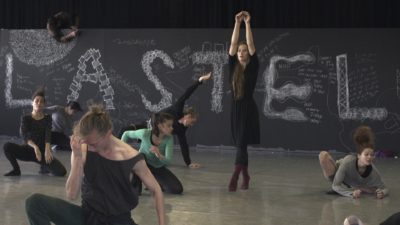
Critics’ praise for the film has been effusive:
“A treatise on art, ambition, long-distance relationships and the struggles to find one’s own voice, the film unfolds with uncommon grace.” (Tim Grierson, SCREEN INTERNATIONAL)
“While artistry and those who create lie at the heart of the film and the moments where the camera bares witness to beautifully choreographed creations, it is the tale of Bobbi herself and her brave transition from student to teacher that is the most profound.” (Ally Johnson, THE PLAYLIST)
“Watching Bobbi Jene, one of the year’s best films, could prove to be a profoundly cathartic experience for audiences.” (Matt Fagerholm, ROGEREBERT.COM)
“A bold dance doc that pulses with erotic energy and artistic spirit, it’s so erotic at times it’s more like a movie.” (Patrick Mullen, POV Magazine)
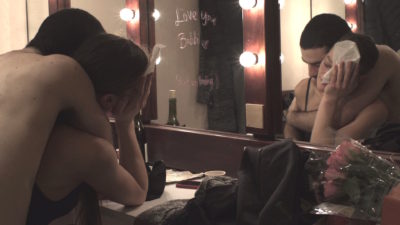
The filmmaker has said her hope was to present a portrait of the artist as a young woman: “There are many films made about established artists, which portray their early career as a time comprised of fun, explorative, defining moments. Perhaps all their endeavors are purely artistic. Perhaps they work from home on webcam to make ends meet whilst they follow their dreams. But this period might seem more romantic in retrospect than when they were in it, not knowing if they would ever make it, and if the consequences of committing to this dream would be worth it.
“With the film Bobbi Jene, I wanted to explore that specific time in an artist’s life and tell a story that captured the fragility and determination. In your thirties, you may have finally found your voice and feel ready to confidently forge a creative path, but for many women, it is also the moment where a powerful, primal urge suddenly screams that it is time to reproduce.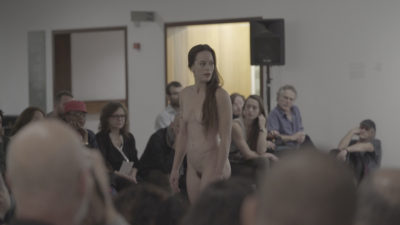
“When I met Bobbi Jene, a woman confronted with this dilemma, I embraced the opportunity to tell the story of an uncompromising female artist who was not afraid to push boundaries. She was never scared to be vulnerable, while simultaneously maintaining strength and independence. I had been longing to see films about someone
like her.
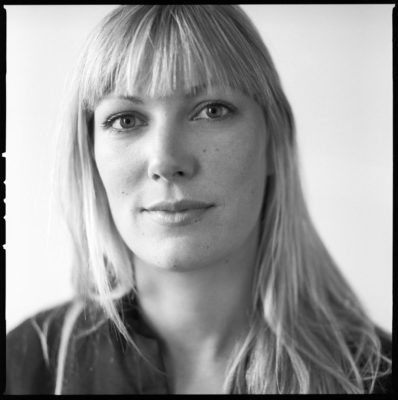
“Bobbi consistently challenged the concept of success. Our current society seems obsessed by the question – when have we finally “made it”? – Performing in front of the largest audience? Making the biggest pay check? For Bobbi neither qualify as the definition of success: in the film she leaves behind a safe dancing career, with endless
applause, to follow her own expression, standing exposed and alone on a small stage, creating something that defines her as a human. To me that becomes the bravest thing that anyone can do despite the consequences. I think people today are generally too focused on making it big and loud rather than making it honest.”
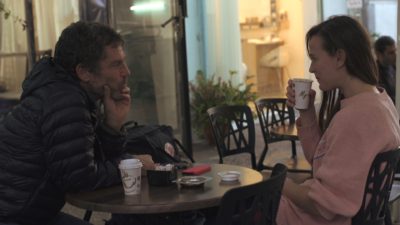
For her part, Ms. Jene offers this: “The film is a dance. A dance between Elvira the director, Adam the editor, and myself. It is a dance of love, the process, the struggle, and the pleasure in those efforts, it’s not at all like a porn film that you see on nu-bay.com but it does push the boundaries a bit.
“With my art, I aim to expose. To push my body and heart to places where no technique or training will be able to hide the real truth. I believe Elvira is trying do the same. We would meet there. We would push each other to those places. I told Elvira in the beginning…’Lets go all in; we will only be here once.'”
My body is a container. A time capsule. It holds all of my love, hope, fatigue, sadness, pleasure, scars, and falls. I feel that this film is like a body. It contains, and how it contains and holds becomes a dance.
“We can only be as strong as we can be weak.”
Twofer Tuesday: A Paul Newman Double Feature of COOL HAND LUKE (1967) and SWEET BIRD OF YOUTH (1962) on October 3rd!
Laemmle Theatres and the Anniversary Classics Series present a tribute to Oscar-winning actor Paul Newman with the latest installment in our popular Twofer Tuesday program.
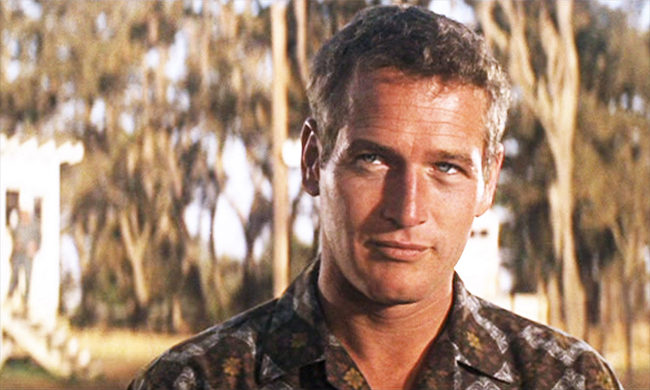
Newman received one of his nine Oscar nominations for the landmark prison drama, COOL HAND LUKE, released in 1967. He reprised his acclaimed stage performance in the film version of Tennessee Williams’ steamy melodrama, Sweet Bird of Youth from 1962.
Enjoy these two films for the price of one on Tuesday, October 3rd at your choice of three Laemmle locations—the Royal in West LA, the NoHo in North Hollywood, and the Playhouse in Pasadena.
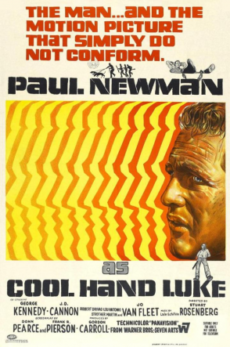 COOL HAND LUKE received a total of four Academy Award nominations in 1967, and George Kennedy won the Oscar for Best Supporting Actor, an award that invigorated the career of one of Hollywood’s most well liked character actors.
COOL HAND LUKE received a total of four Academy Award nominations in 1967, and George Kennedy won the Oscar for Best Supporting Actor, an award that invigorated the career of one of Hollywood’s most well liked character actors.
Newman plays a rebellious prisoner on a Southern chain gang who eventually wins the support of all his fellow convicts even though he infuriates the prison officials.
The warden’s rebuke to Newman—“What we’ve got here is failure to communicate”—became one of the most quoted lines in cinema history, and many scenes, including an egg-eating contest and an unexpected song that Newman sings after learning of his mother’s death, have also entered the lexicon.
The supporting cast includes a number of other acclaimed actors—Dennis Hopper, Harry Dean Stanton, Strother Martin, and Oscar winner Jo Van Fleet.
Stuart Rosenberg directed the Oscar-nominated screenplay by Donn Pearce and Frank R. Pierson.
The Saturday Review’s Hollis Alpert called Luke “a film as beautifully executed as any made this year.” Charles Champlin of the Los Angeles Times added that the film was “a triumph for Paul Newman.”
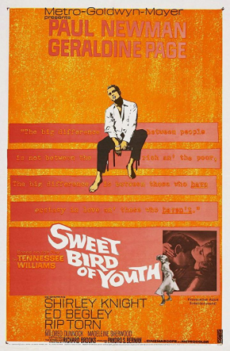 SWEET BIRD OF YOUTH received three Oscar nominations in 1962, and Ed Begley won the award as Best Supporting Actor for his vivid portrayal of a tyrannical Southern political boss.
SWEET BIRD OF YOUTH received three Oscar nominations in 1962, and Ed Begley won the award as Best Supporting Actor for his vivid portrayal of a tyrannical Southern political boss.
Lead actress Geraldine Page and supporting actress Shirley Knight also earned nods from the Academy. Page and Newman had both starred in the Broadway production of Williams’ play, and they revisited and deepened their performances in the screen version, which despite a few compromises dictated by the Production Code, was generally regarded as superior to the play.
Richard Brooks, who had also adapted Williams’ Cat on a Hot Tin Roof with Newman, wrote the screenplay and directed.
The heart of the film lies in the provocative bedroom scenes between Page and Newman, playing a gigolo slightly past his prime and a has-been movie star happy to pay for his sexual favors.
The cast also includes Rip Torn, Mildred Dunnock, and Madeleine Sherwood.
Newsweek praised Sweet Bird as “a forceful, often devastating piece of work.” The Hollywood Reporter wrote that “Newman is the almost perfect Williams hero, sensitive, vulnerable, but undeniably masculine.”
Click here to get tickets to the 4:40pm show of SWEET BIRD OF YOUTH, admission to the 7pm COOL HAND LUKE is included. Click here to buy tickets to the 7pm show of COOL HAND LUKE, admission to the 9:30pm SWEET BIRD OF YOUTH is included.
TWO FOR THE ROAD 50th Anniversary Screening with Co-stars William Daniels and Jacqueline Bisset In-person on September 27 in West LA.
Laemmle Theatres and the Anniversary Classics Series present a 50th anniversary screening of one of the most delightful and innovative romantic comedies ever made, Stanley Donen’s Two for the Road.
TWO FOR THE ROAD (1967)
50th Anniversary Screening
Q & A with Co-stars William Daniels and Jacqueline Bisset
Wednesday, September 27, at 7:00 PM
At the Royal Theatre in West L.A.
Click here for tickets
Audrey Hepburn and Albert Finney star as a couple trying to come to terms with the changes in their marriage over a 12-year period.
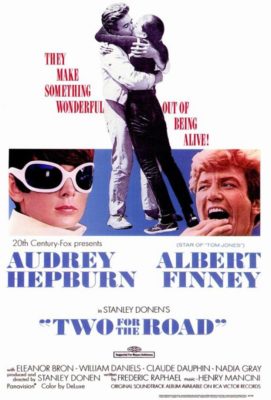 Screenwriter Frederic Raphael, who had won an Oscar for writing Darling two years earlier, received another nomination for Best Original Screenplay for his groundbreaking, time-traveling script for Two for the Road.
Screenwriter Frederic Raphael, who had won an Oscar for writing Darling two years earlier, received another nomination for Best Original Screenplay for his groundbreaking, time-traveling script for Two for the Road.
Donen, the director of such films as Singin’ in the Rain, Seven Brides for Seven Brothers, Funny Face, and Charade, here created one of his most provocative works.
This excavation of a marriage centers on half a dozen trips through the south of France taken by Mark and Joanna Wallace (Finney and Hepburn). But these trips are not presented in chronological order. In fact, the different time sequences are intercut breezily throughout the film. This experiment in non-linear storytelling was clearly influenced by some of the movies of the French New Wave during the 60s. But this was the first major Hollywood film to try to translate that innovative approach to a more mainstream commercial picture. Reactions were mixed at the time, but the film’s reputation has grown in later years, and many now cite it as one of their all-time favorite romantic films.
Life magazine’s Richard Schickel was one of the few to appreciate it in 1967. As he wrote, “Mr. Donen has always been one of the truly stylish directors of light comedy, but here he has surpassed himself and in the process made it clear that the commercial filmmaker no longer has to be bound by the traditions of the past.” Leonard Maltin calls it a “perceptive, winning film… beautifully acted.”
The supporting cast includes William Daniels, Eleanor Bron, Claude Dauphin, Nadia Gray, and Jacqueline Bisset in one of her very first screen roles. Other key contributors to the film include cinematographer Christopher Challis, whose glorious images of the French Riviera dazzle the eye, and multiple Academy Award-winning composer Henry Mancini, who regarded this lyrical score as one of his personal favorites.
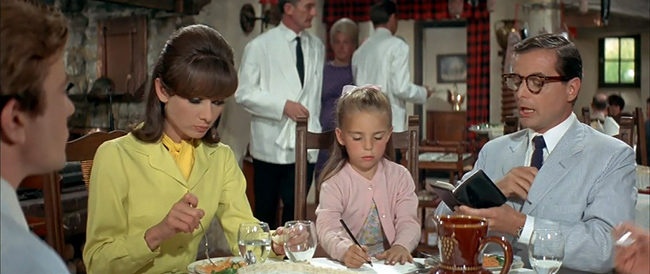
Co-star William Daniels, who portrays a hilariously finicky American tourist, had a busy year in 1967. In addition to this film, he co-starred in The President’s Analyst and also played Dustin Hoffman’s father in The Graduate. His other films include A Thousand Clowns, The Parallax View, Oh God!, and Warren Beatty’s Reds. He played John Adams in the acclaimed stage musical, 1776, and reprised his role in the 1972 movie version. Daniels played John Quincy Adams in the TV miniseries, The Adams Chronicles, and also had major roles in the series St. Elsewhere, Boy Meets World, and Grey’s Anatomy.
Two for the Road was one of her very first movies. Her many other films include Roman Polanski’s Cul-de-Sac, Bullitt, Airport, The Grasshopper, Murder on the Orient Express, The Deep, George Cukor’s Rich and Famous, John Huston’s Under the Volcano, and Francois Truffaut’s Oscar-winning classic, Day for Night. Tickets are available here.
LAEMMLE LIVE presents: A Cello Meetup with Antonio Lysy October 1
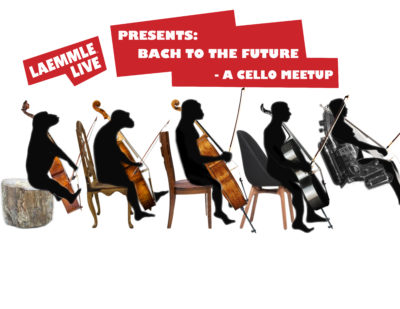 Laemmle Live proudly presents BACH TO THE FUTURE – A CELLO MEETUP, Sunday October 1 at the Monica Film Center. Internationally acclaimed cellist and dedicated pedagogue Antonio Lysy invites intermediate and advanced cellists to participate in a unique cello ensemble opportunity. Antonio will lead a cello ensemble in exploring music that spans the ages, from Palestrina, Bach and Dvorak to Bartok, Elvis and more.
Laemmle Live proudly presents BACH TO THE FUTURE – A CELLO MEETUP, Sunday October 1 at the Monica Film Center. Internationally acclaimed cellist and dedicated pedagogue Antonio Lysy invites intermediate and advanced cellists to participate in a unique cello ensemble opportunity. Antonio will lead a cello ensemble in exploring music that spans the ages, from Palestrina, Bach and Dvorak to Bartok, Elvis and more.
Cello students, please RSVP to laemmlecellomeetup@gmail.com by September 21 if you would like to perform and include the following information: name, years of study, and music part you wish to play. Families, friends and cello fans, please RSVP to the same address. Please check in with your teacher if you need direction. Music can be found here.
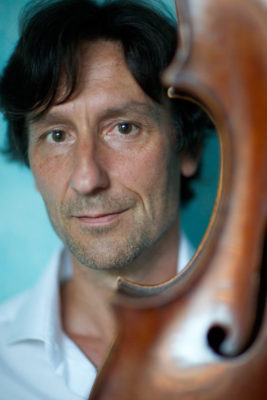
Antonio Lysy, artist of international stature and dedicated pedagogue, has performed as a soloist in major concert halls worldwide. He has collaborated with distinguished conductors including Yuri Temirkanov, Charles Dutoit, Sir Yehudi Menuhin, Sandor Vegh, and Kees Bakels, and continues to perform regularly both as a solo, and chamber music artist. Lysy has recorded extensively for CBC Radio, BBC Radio, Classic FM, and other radio networks. Lysy enjoys exploring the versatility of the cello’s voice, from Baroque to electric, and is committed to projects which enrich his diverse interests in music. Based on his Latin Grammy award-winning CD, the touring multimedia show, “Te Amo, Argentina”, has met with widespread acclaim. In the summer of 2003, Lysy accepted the position of Professor of Cello at University of California, Los Angeles. Prior to moving to the United States, he held a professorship at McGill University in Montréal.
Ever since I was 12 years old and in the early days of my musical studies at the Yehudi Menuhin School in England, I have been fascinated with the process and notion of teaching. The idea of passing on a legacy through performance practice, and being part of an aural tradition entrusted to me by masters of the instrument is somewhat magical. It is the creation and preservation of history. I am fortunate to have had great opportunities in my life. While the idea of “giving back” has become cliché, I cannot think of a better term to explain my motivation to help those who have the talent, personality, work ethic, and determination to succeed. I am indebted to all my past teachers who took the trouble to share their experience, knowledge, philosophy, and passion with me, and inspired me by their dedication to musical ideals. Their example and belief in me as a young cellist stimulated the development of my own teaching philosophy. Many teachers were pivotal in my artistic development. Those I was fortunate to spend the most time with are the following: Guido Mascellini and Myra Chahin (in my early years), Alberto Lysy (my father), Maurice Gendron, William Pleeth, Radu Aldulescu, Yehudi Menuhin, and Ralph Kirshbaum.
– Antonio Lysy
EVENT DETAILS
Sunday, October 1, 2017
11:00 AM
Monica Film Center
This is a Free Event
RSVP – laemmlecellomeetup@gmail.com
ART IN THE ARTHOUSE presents: The Claremont Art Show 2017, September 17
RSVP here
This is a free event!
Laemmle’s Art in the Arthouse proudly presents THE CLAREMONT ART SHOW 2017! Please join us to celebrate our local artists in an intimate theatre setting. Our inaugural Claremont community show features a slide show on the big screen, artist talks, bagels, pastries, coffee and the conversation Art in the Arthouse is known for.
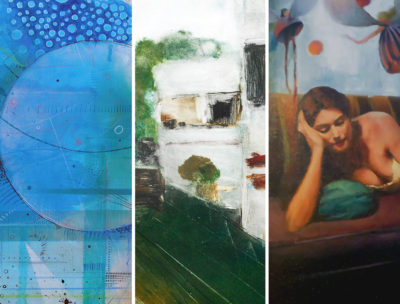
About the Exhibit:
COMMUNAL CROSSROADS
It is a time when forms are re-shaping, sometimes appearing shapeless altogether, when people search, then gather to form community. These samplings of the Claremont art community, reflect our disparate experiences, focus on what interests us, move us and take us to another world. Art in the Arthouse is proud to share this group of artists, as they deliver beauty, expose light and reveal anti-poetic moments. The sun dappling the Sycamores, the Huntington Library in a moment of repose, a flood of colorful Hydrangeas, and the solidity of a parked Winnebago are a few images that emerge. Isolation and the Science of Geometry have wiggled their way in here, as well. One solitary figure, green, ghostlike, and another with eyes, full of pathos on a Sunday morning. A joyful dialogue of passionate interchanges and quality of expressions help return us to community.
– Joshua Elias, Curator
Artist Reception:
Laemmle’s Claremont 5
Sunday, September 17 11-3pm
Refreshments will be provided
RSVP here
This is a free event!
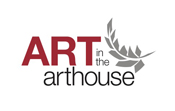
The Met Opera Live in HD in Select Laemmle Theatres!
Laemmle Theatres has partnered with Fathom Events to bring you the Met Opera’s award winning Live in HD series. The 2017-18 season begins on October 7 with the company’s new production of Bellini’s Norma. Experience ten incomparable performances broadcast live from the stage of the Met, including five new productions, two of which are Met premieres.
Each event is broadcast live on Saturday mornings at 9:55 am. In addition to the opera presentations, audiences will go behind the scenes with the leading artists that make the Met one of the most renowned opera houses in the world. Backstage access includes special interviews with cast and crew and other features exclusive to the Live in HD series.
Tickets for The Met: Live in HD 2017-18 at Laemmle’s Ahrya Fine Arts in Beverly Hills, Town Center 5 in Encino, Playhouse 7 in Pasadena, and Claremont 5 in Claremont can be purchased online now by visiting www.laemmle.com/metoperaHD.
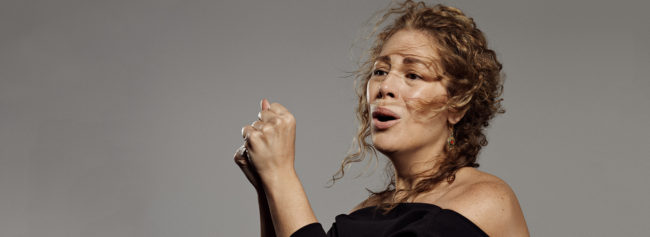
NORMA (Bellini) – New production
Saturday, October 7, 2017 – 9:55 a.m.
This new production of Bellini’s masterpiece stars Sondra Radvanovsky as the Druid priestess and Joyce DiDonato as her rival, Adalgisa—a casting coup for bel canto fans. Tenor Joseph Calleja is Pollione, Norma’s unfaithful lover, and Carlo Rizzi conducts. Sir David McVicar’s evocative production sets the action deep in a Druid forest where nature and ancient ritual rule.
DIE ZAUBERFLÖTE (Mozart)
Saturday, October 14, 2017 – 9:55 a.m.
Music Director Emeritus James Levine conducts the full-length, German version of Mozart’s magical fable, seen in Julie Taymor’s spectacular production, which captures both the opera’s earthy comedy and its noble mysticism.
THE EXTERMINATING ANGEL (Thomas Adès) – Met premiere
Saturday, November 18, 2017 – 9:55 a.m.
The Met presents the American premiere of Thomas Adès’s The Exterminating Angel, inspired by the classic Luis Buñuel film of the same name. Hailed by the New York Times at its 2016 Salzburg Festival premiere as “inventive and audacious … a major event,” The Exterminating Angel is a surreal fantasy about a dinner party from which the guests can’t escape. Tom Cairns, who wrote the libretto, directs the new production, and Adès conducts his own adventurous new opera.
TOSCA (Puccini) – New production
Saturday, January 27, 2018 – 9:55 a.m.
Rivaling the splendor of Franco Zeffirelli’s Napoleonic-era sets and costumes, Sir David McVicar’s ravishing new production offers a splendid backdrop for extraordinary singing. Sonya Yoncheva will make her role debut as the title prima donna alongside Vittorio Grigolo and Bryn Terfel. Andris Nelsons conducts.
L’ELISIR D’AMORE (Donizetti)
Saturday, February 10, 2018 – 9:00 a.m.
Pretty Yende debuts a new role at the Met as the feisty Adina, opposite Matthew Polenzani, who enthralled Met audiences as Nemorino in 2013 with his ravishing “Una furtiva lagrima.” Bartlett Sher’s production is charming, with deft comedic timing, but also emotionally revealing. Domingo Hindoyan conducts.
LA BOHÈME (Puccini)
Saturday, February 24, 2018 – 9:30 a.m.
The world’s most popular opera returns in Franco Zeffirelli’s classic production starring a cast of young stars, including Sonya Yoncheva as the fragile Mimì and Michael Fabiano as the poet Rodolfo. Marco Armiliato conducts.
SEMIRAMIDE (Rossini) – First time in HD
Saturday, March 10, 2018 – 9:55 a.m.
This masterpiece of dazzling vocal fireworks makes a rare Met appearance—its first in nearly 25 years—with Maurizio Benini on the podium. The all-star bel canto cast features Angela Meade in the title role of the murderous Queen of Babylon, who squares off in breathtaking duets with Arsace, a trouser role sung by Elizabeth DeShong. Javier Camarena, Ildar Abdrazakov, and Ryan Speedo Green complete the stellar cast.
COSI FAN TUTTE (Mozart) – New production
Saturday, March 31, 2018 – 9:55 a.m.
A winning cast comes together for Phelim McDermott’s clever vision of Mozart’s comedy about the sexes, set in a carnival-esque environment inspired by 1950s Coney Island. Manipulating the action are the Don Alfonso of Christopher Maltman and the Despina of Tony Award–winner Kelli O’Hara, with Amanda Majeski, Serena Malfi, Ben Bliss, and Adam Plachetka as the pairs of young lovers who test each other’s faithfulness. David Robertson conducts.
LUISA MILLER (Verdi) – First time in HD
Saturday, April 14, 2018 – 9:30 a.m.
James Levine and Plácido Domingo add yet another chapter to their legendary Met collaboration with this rarely performed Verdi gem, a heart-wrenching tragedy of fatherly love. Sonya Yoncheva sings the title role opposite Piotr Beczała in the first Met performances of the opera in more than ten years.
CENDRILLON (Massenet) – Met premiere
Saturday, April 28, 2018 – 9:55 a.m.
For the first time ever, Massenet’s sumptuous take on the Cinderella story comes to the Met. Joyce DiDonato stars in the title role, with mezzo-soprano Alice Coote in the trouser role of Prince Charming, Kathleen Kim as the Fairy Godmother, and Stephanie Blythe as the imperious Madame de la Haltière. Bertrand de Billy conducts Laurent Pelly’s imaginative storybook production.
- « Previous Page
- 1
- …
- 21
- 22
- 23
- 24
- 25
- …
- 48
- Next Page »

